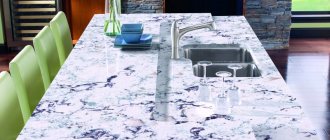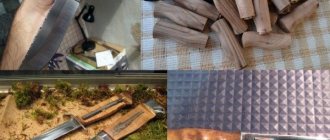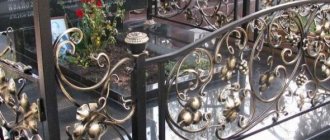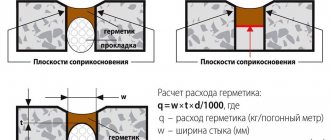A number of undoubted advantages can make artificial stone the most popular material for finishing indoors and outdoors. The material imitates the shape and structure of a natural mineral. Thanks to the ability to use a wide palette of colors for painting concrete, it is possible to obtain concrete panels of various shades.
Artificial marble has excellent physical and chemical qualities. It has durable properties. The material is not subject to deformation when exposed to high and low temperatures. It does not burn, so its use is important for finishing stoves and fireplaces.
The stone has low thermal conductivity and can serve as additional thermal insulation for the facade. Another undoubted advantage is that it does not conduct electricity. It is often used to insulate and decorate ovens, radiators and other electrical devices.
The unique color and pattern do not fade under ultraviolet rays. The material is well resistant to moisture. Thanks to its durable properties, concrete objects can last a long time. If cracks appear, non-natural marble can be easily restored and return to its original appearance. In addition, it does not emit toxic substances into the atmosphere, which indicates a high level of environmental friendliness. The production process does not leave waste, so the use of concrete stone is effective and profitable.
When all the ingredients are mixed, the resulting mixture can take any shape. The connection of its parts occurs according to the principle of puzzles. All joints are reliably bonded to each other using adhesives and provide high strength to the entire surface.
Artificial stone is lightweight in contrast to natural mineral, so it is easier to process and install. Typically, the material is created according to the initially specified parameters. Natural marble requires additional polishing and trimming before installation.
DIY marble concrete
Painting concrete to look like marble
All the tools and components needed to produce marble concrete can be purchased at any hardware store.
You will need the following components:
- Pure water acts as a solvent.
- Polyethylene film.
- Fine sand. It is advisable to find the smallest possible fraction without impurities and excess dirt, so as not to waste time on cleaning.
- Gravel or small pebbles act as a filler for marble. They must also be free of excess dirt and impurities, which only spoil the structure of the material.
- Dye. It is necessary to take oil-based and very high-quality paint in several shades to create a natural effect.
- A plasticizer is a specialized additive that will increase the strength of the material.
- The most important component is cement. It is the basis of the future concrete mixture. Cement marked M500 or M400 is suitable for this task.
As for the tools, you need to find:
- Container - for mixing concrete.
- Drill with mixer attachment - for mixing components.
- Forms - for pouring the mixture. You can make them yourself from clean plastic containers.
Composition and special properties of artificial marble
The main components of cast marble are polyester resin and pigment mineral dyes and hardeners. Having mastered the mixing technique, you can get streaks and stains that are practically indistinguishable from stains and veins on natural marble.
- The material is non-flammable and dielectric, i.e. does not conduct electric current, so it can be used for any finishing work without restrictions. Resistance to alkaline preparations and chemical solvents contributes to its hygiene and allows it to be used as countertops and kitchen sinks.
- The composition of cast marble has a homogeneous structure, does not delaminate, is resistant to corrosion and is an environmentally friendly material. The outer surface of cast marble is gelcoat and has decorative and protective functions. The filler is polyester resin mixed with multi-colored mineral chips and pigment dyes. To obtain a durable mass, a hardener is added.
- Simpler methods for producing artificial marble involve the use of cement-concrete mixtures and crushed stone as filler. Pebbles, quartz fine crushed stone and tinted sand are often used.
Step-by-step instructions for making marble from concrete
Which technology is best used to make marble from concrete must be decided depending on the specific conditions of use. The basic principles are the same. Making artificial marble at home will look like this:
Table of approximate correspondence between class and grade of concrete.
- The first stage is preparatory. The mold (or molds) must be thoroughly washed and dried. It can be of any size: for example, it can be specially made in accordance with the required values for the kitchen wall. To prepare the solution, you need to mix the dry ingredients until smooth: sand, pebbles and cement. After receiving the composition, pour in almost all the water, add the plasticizing ingredient. Continue kneading until the mixture is as smooth as possible.
- Add the rest of the water, then the dye - it must be introduced in portions of different sizes, always in different parts of the container. In this way, uneven mixing of the solution and color is achieved, which makes the artificial material more similar to natural stone.
- Filling the mold with solution. When the dye disperses in thin veins throughout the cement mass, we can consider that the composition is finally ready. Now you can move on to the most important phase of the technological process. The mold should be placed on a smooth surface - this will help prevent bending of the walls and bottom. Pour the solution into it. Using a spatula, the edges of the mold are cleaned of excess sagging, which can affect the appearance and smoothness of the surface of the slab, then the surface is leveled as a rule and covered with polyethylene.
Technology Marble from concrete, Kevlar concrete, Granilite and Ultra concrete
The Marble concrete technology, unlike others, requires a forced-action turbulent mixer. For example, like the one in the photo.
Forced action concrete mixer
There are a large number of such mixers. They differ in volume and power. The options for mixers and their application features are described in sufficient detail in the article on the types of concrete mixers.
Partially this technology (also called Systrom) has already been used in the production of original decorative tiles (and a short video).
But then the concrete mixer was not used, since only a few stones needed to be made.
Using this technology, two cement mortars (but there may be more) of different colors and quantities are prepared.
In advance, the plasticizer, accelerator and water are mixed separately. The water-cement ratio is 0.28.
A smaller volume of solution is added to the mixer with a larger quantity of solution.
Make several revolutions of the mixer.
The mixture is poured into molds on a vibrating table. Vibration takes about half a minute.
Finished tiles are removed from the molds when their surface cannot be scratched by a fingernail.
To ensure that the products remain glossy, they are placed in plastic bags with their front sides facing each other.
Manufacturing technology
The process of preparing a solution for artificial marble is simple. However, it requires accuracy in proportions, adherence to certain rules and the presence of minimal skills. It is better to start by making simple structures, gradually complicating the task.
Preparation of the solution
To prepare the solution you need:
- Pour cement and river sand in a ratio of 1:2 into a clean, dry container. After thoroughly mixing these materials, marble chips or pebbles are dropped into the resulting mixture. Its quantity is determined individually and affects the size of the finished product fractions.
- Following the filler, dye is added to the mixture. Its amount should not be more than 1% of the total mass of the mixture.
At this stage, it is important to carefully mix the composition in order to maintain uneven coloring. This will allow you to replicate the pattern of natural stone as much as possible.
- Afterwards, you need to shake the resulting mixture well several times or place it on a vibration table to remove air.
- Then you can pour in water. It should be 0.2 parts, but this must be done in 2 steps. The first time, 80% of the total volume is added, and after mixing in the plasticizer (1% by weight of cement) and thoroughly mixing the mixture, the remaining 20%. After another stirring and vigorous shaking, the solution is ready.
Preparing and filling out the form
The resulting mass can only be poured into dry and clean molds placed in a strictly horizontal position. They are pre-treated with anti-adhesion material and gelcoat and left to harden. Ideally even slabs are obtained if the solution is poured in small portions, making sure that it evenly fills the container. Periodically, the molds should be shaken vigorously or placed on a vibration table to remove air.
You can increase the strength of finished marble slabs using reinforcement. To do this, it is enough to place a strong, painted wire into the mass.
Filled mold with solution
After removing excess solution and leveling it, the mold is covered with plastic film and left in a place protected from precipitation to harden for at least a day. In some cases, this process may take several days. There is no point in additionally moistening the surface of the concrete or interfering with it in any way.
Thick slabs of artificial marble may break down later due to the presence of internal voids. This can be prevented by a vibrating table or a special solution preparation technique. According to it, the mixer should not be removed from the mass while mixing it. This way you can avoid the appearance of air bubbles.
Finished slab processing
After hardening, the product is turned over and removed from the mold, removing it like a cover. Then it is advisable to let it sit in the open air for a while and begin sanding. This can be done using a grinding machine.
Artificial marble production technology
Nowadays it is difficult to distinguish real stone from artificially made material. After all, even at home, in a short period of time you can create a high-quality product that will last for a long time.
Kawabanga! Drainage trays: 10 tips for selection and installation
The creation of marble concrete takes place in several stages.
#1 Stage – Mixing the concrete mixture
After preparing all the materials and tools for work, you can begin making marble slabs. To begin, mix in a deep container:
#2 Stage – Adding color
It is better to use paints of similar shades to achieve the effect of heterogeneity and naturalness. At this stage there is freedom for creativity.
The dye is introduced in portions. After adding color, you need to mix the composition with a special tool, but you can also use gloved hands.
#3 Step – Adding water
#4 Stage – Creating forms
Polymer forms are best suited for these purposes. When the solution is ready, you need to pour it into the finished stamps. After this, cover with plastic wrap until completely dry.
#5 Stage – Sanding
When the concrete has completely hardened, you need to remove the resulting products from the molds. Next comes grinding the marble so that the product adheres well to the surface to which it will be attached.
Polishing is also done to make the marble look more realistic.
Cast marble
The base for this material is polyester resin and any mineral filler (marble chips, crushed white quartz and other fine components). The latter make it possible to produce slabs stylized as granite, malachite, jasper and onyx.
To make cast artificial marble at home, you will need to prepare a solution:
- Polymer concrete. To do this, you need to mix 20-25% polyester resin with 75-80% crushed neutral mineral.
- Butacryl. In this case, instead of resin, AST-T and butacryl are used in equal proportions, after which 50% quartz sand or crushed crushed stone is added to the mixture.
You will also need to prepare river sand, pigment, gelcoat and plasticizer. The technology for manufacturing artificial marble from resin includes the following steps:
- Lubricate the matrix for the future artificial stone with gelcoat and let the form dry.
- Prepare the solution using one of the methods described above.
- Pour the liquid solution into the matrix and remove any excess.
- Cover the mold with film and wait 10 hours.
- Remove the finished artificial stone from the mold and leave it in the open air for a while.
The hardened stone can be further polished or left without machining.
Despite the simplicity of producing such artificial raw materials, the casting method of producing marble is highly expensive, so it makes sense to consider other methods of creating stones.
Composition and manufacturing methods
Marble concrete is made from a mixture that includes: binder, aggregate and water.
Kawabanga! Technologies for the production of polymer concrete and the production of products from it
Depending on the selected substances, one or another type of artificial stone is obtained.
Casting method
Do-it-yourself concrete marble is made by casting stone chips, which are obtained as industrial waste of quartz sand and additional components. Shades of the product are given by pigment dyes, and polyester resin gives the composition a uniform structure.
The finished solution is poured into a container coated with an anti-adhesive compound and placed on a vibration platform to reduce the porosity of the product and remove excess air bubbles.
Gypsum marble
In addition to concrete with marble chips, artificial stone is made from building gypsum.
The components of the base mixture are:
- water;
- polyester resin;
- carpentry adhesives;
- dyes and other auxiliary substances.
Using a drill with an attachment, plaster, water, adhesives, added resins and color-giving components (humilax) are mixed. Wherein:
- Snow-white color is obtained from white pigment.
- An orange pigment diluted with alcohol allows you to create various beige shades.
- Aniline dye is the source of black color.
Products made from gypsum are light, but fragile. Most often they are used for decorative purposes in the absence of loads.
Concrete based
To obtain marble from concrete, according to the technology you will need:
- mixer;
- container for mixing the solution;
- reinforcing wire, mesh;
- film;
- forms;
- water;
- suitable dyes;
- sand;
- plasticizer;
- Portland cement M400 or M500.
Cement and sand, previously sifted, interfere. The proportions, which may be different, depend on the type of final product. Add the mixture, water and 1-2% (by weight of cement) plasticizer, mix, leave for 15 minutes and mix again.
The well-mixed finished mixture is poured into a mold pre-treated with anti-adhesive substances. For large products, reinforcement is used.
Areas of use
The use of decorative material significantly improves the exterior and evokes admiring glances. The original texture of the material allows it to be used for finishing and decorating the outside of premises:
- execution of external cladding;
- implementation of territory design solutions;
- laying sidewalks in recreation areas.
Undoubtedly, marble concrete is used not only for decorative finishing of buildings on the street side and landscape design. It is also popular inside apartments, where it is used for:
- Decorative finishing of residential premises.
- Applications instead of ceramic tiles in the bathroom, kitchen, toilet.
- Fireplace linings.
- Formation of floor coverings.
- Manufacturing of countertops, window sills, railings, balusters, stairs, various interior items.
The affordable price of concrete products that imitate marble allows consumers to realize their fantasies for decorating a building and improving the interior of a room.
You should know that artificial marble can also be made from gypsum, as well as other building materials that are no less common today. However, concrete marble is the most popular due to the ease of its manufacture.
To make concrete marble with your own hands, you will need the following components:
- Cement not lower than M400-500;
- Plain water;
- Plasticizer C3 - you can read about different types of plasticizers by going to another article;
- Fine sand;
- Pigment additives;
- Gravel - will be used as filler;
Well, it goes without saying that to make marble from concrete you will need empty containers for mixing the solution, plastic film and molds.
Concrete marble manufacturing technology
So, when all of the above components are prepared, and the materials for making marble from concrete have been purchased, you can safely begin the work. Initially, you will need to take into account some preparatory issues regarding forms. The forms should be rinsed and dried.
You should know that a mold for concrete marble must be made taking into account the dimensions of a concrete countertop, for example, or any other product. The production of molds and stamps for decorative concrete has already been discussed in previous issues of the magazine.
To summarize: is it important to understand how to make marble from concrete with your own hands?
Having information about the production of an original concrete composite, you can make extraordinary products on your own for interior decoration and improvement of the premises, as well as improving the exterior and design of the territory. The technology is becoming increasingly popular due to its advanced capabilities and minimal costs. It is easy to master both for internal needs and for setting up serial production. To ensure quality, it is important to use proven raw materials and follow technology. This is the main key to success!
Composition of the cement mixture
The composition of the cement mixture that Dmitry uses.
Gray cement M500 D0 – 5 kg
Granite screenings (0...5 mm) – 8 kg
2 pigments 50 g each
Plasticizer C3 – 40 g per 1 l (6% of cement)
The balls are obtained from 0.5 to 5 cm. In order to avoid waste, usually use no more than 20% of the volume of the mixer.
While preparing the mixture, it must be raked away from the back wall of the mixer. It is advisable to supply water with a plasticizer through a sprayer rather than pouring it into a mixer. The angle of inclination of the concrete mixer must be selected. Usually it is 15 degrees. Speed – about 25 rpm.
The vibration time depends on the amount of plasticizer introduced and the W/C value.
Since this time is not short, the drawing turns out blurry.
The photo shows one of the examples of his tiles.
Marble tiles
The blurred pattern is less noticeable on colors that are similar in tone. The photo shows an example.
Marble tiles
Low productivity is a disadvantage of this method.
Therefore, it is mainly used for the production of large products: monuments and concrete fences.
At the same time, uneven coloring on large surfaces is not so noticeable.
Manufacturing technology of artificial marble with concrete filler
This method is very simple and affordable, both in terms of manufacturing technology and costs. Due to this, this method is widely popular. Countertops and kitchen boards are highly durable, and environmentally friendly materials are used in their production.
- First of all, you will need a mold (matrix) made of polyurethane, plastic, gypsum or other suitable material. You can make a frame from a corner or wood, and make the bottom glass. It is important that the surface of the casting mold is perfectly smooth and dry, and that the frame is detachable for ease of removal of the finished product. The mold can be ordered from a workshop, but it is quite expensive.
- The inner surface of the mold is coated with gelcoat. Gel coats vary in color and environment of use. Choose a moisture-resistant gelcoat and only after it has completely dried, you can fill the form with concrete or gypsum filler. Slaked lime or clay is used as a plasticizer or filler.
- Prepare the filler for the bulk of the product. To do this, mix sand and cement in a 2:1 ratio, add crushed stone or pebbles and a plasticizer as filler. Mix thoroughly, preferably in a mixer, until smooth. Pigment dye is added to different sectors of the container with filler in uneven portions and mixed until veins and spots are created.
- The form is placed in a strictly horizontal position and a mass of artificial liquid marble is poured into it in small portions. Make sure that all the voids in the matrix are filled. Excess mortar is removed with a spatula; cover the top with plastic wrap. Depending on the thickness, artificial marble dries within 24 hours in natural conditions and at above-zero temperatures. The dried slab is removed from the mold and processed with a grinding machine and transparent polish.
Artificial marble in the interior
It would seem that marbled concrete is mainly used outside the living space. Indeed, fences made of such material look majestic. Nevertheless, artificial marble has found its application inside apartments.
Where you can see it:
- decoration of walls of residential premises;
- in the bathroom - an excellent alternative to standard tiles;
- countertops and other interior items in the kitchen (and in the most unexpected places, but they look unusual and rich);
- a fireplace is not only a source of home comfort, but also a luxury item (especially if it is made of marble, albeit artificial);
- floor coverings.
If you are still thinking about how to make marble from concrete at home, watch a video on this topic and get to work quickly. The result, if not surprising, will definitely please you, rest assured.
Step-by-step instruction
Before making marble from concrete, all the ingredients must be prepared because the process cannot be interrupted.
Kawabanga! Requirements for arranging a country toilet
To produce artificial stone, technological operations are performed in the following sequence:
After filling the solution, the molds are covered with polyethylene film and left for 10-15 days.
To give artificial marble made of concrete the desired color, a coloring pigment must be added to the prepared solution. The composition should be heterogeneous to resemble a natural mineral. To do this, do not mix the solution too thoroughly.
To produce cast objects with unusual patterns, paints of several colors are used. During the mixing process, spots, dots, wrinkles, streaks and bends of various shapes are obtained, which give the product originality, limited only by the author’s imagination.
In relation to the dry component of the material, water is calculated 1:2. First, pour in 80% of the liquid and mix well. To increase the strength of the elements being created, at least 1% C3 plasticizer is added to the solution.
After further mixing and resting for several minutes, the finished material will become viscous and plastic. At the final stage, the remaining 20% of water is distributed throughout the composition.
Form
Molding is needed to give a pre-prepared look to future products.
The polymer resin is applied in several layers with a spray gun or brush. It will take 2-3 hours to dry.











